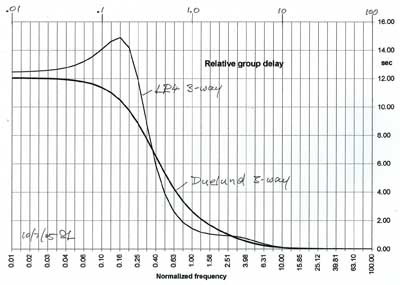dallaire said:
All I want to do is build the perfect speaker!!
.....seems "EVERTHING" is a tradeoff!!!....
Vince
Hi,
There is no such thing as the perfect speaker, there is such a thing
as designing it properly, which requires understanding what is going
on. Getting involved in the semantics of perfect performance in any
area whilst ignoring the basics of design is pretty pointless.
For a WMTMTW used horizontally a centre speaker you would be
better off with vertical MT arrangement. Placed lower than ear
height an inverted MT would probably equalise path diffrences.
For the inverted MT you are deliberately using off axis lobing to
improve time and frequency performance at the listening position.
If the time domain performance of 4th order L/R does not appeal
there is an alternative "Duelund" outlined by Linkwitz himself here :
http://www.linkwitzlab.com/crossovers.htm

So then Sreten, what your saying then is to use for center design, "in my case" I have ordered two 6.5 woofers, two 4 inch mids, and one tweeter. You think I sould then use the two woofers and one four inch mid and one tweeter. The one mid and one tweeter should then be placed in center of horizontal six inch woofers, with the midrange vertically alligned "on top" of the tweeter? My center does sit lower than ear level in my dedicated room, because in the back I have a raised platform "one foot" and center sits below screen in front of room. I just want to understand you correctly
Thanks,
Dallaire
Thanks,
Dallaire
Hi,
Yes you have understood me correctly, but the MT should only be
inverted if you can get it to work properly on the design axis.
http://www.rjbaudio.com/Audiofiles/FRDtools.html
http://www.geocities.com/woove99/Spkrbldg/
If you want to work out what going in.
 /sreten.
/sreten.
Yes you have understood me correctly, but the MT should only be
inverted if you can get it to work properly on the design axis.
http://www.rjbaudio.com/Audiofiles/FRDtools.html
http://www.geocities.com/woove99/Spkrbldg/
If you want to work out what going in.
Thanks, I will check out these links. would it be better to design the speaker using both four inch mids in a "D'Appolitto" array "vertically" in middle, and then have the two six inchers right and left? or would this just screw up the intended lobing of using the "one" mid and tweeter? I can make the speaker any configuration. It is gonig to sit below projection screen on top of six inch raised "stage" at front of room. I'm also building a stand for the new center that can tilt, so as I can aim it vertically.
Anyway, what "do" you think about using the "two" mids? already on there way, this is why I ask..
Thanks again,
Dallaire
Anyway, what "do" you think about using the "two" mids? already on there way, this is why I ask..
Thanks again,
Dallaire
OK, when you say triangle config. you are talking about two mids on top horizontaly, (close together) and the single tweeter on the bottom? with this configuration, I have noticed that the edge diffraction is a litter nicer with two mids vert close (horizontaly) placed at middly top of box and tweeter just below. Can the same lobing be achieved using the two mids with this config. as opposed to just one mid?
Thanks,
dallaire
Thanks,
dallaire
I have a Rane active crossover with adjustable time dalay for the mid-bass towers and treble ribbon towers, as is common in semi-pro and pro equipment. So normally for a folded horn I measure the distance of the acoustical path of a folded horn and use speed of sound to convert that to time. Of course I also adjust that distance and time to accomodate the distance between the mid & treble drivers and front of the horn cabinet, etc.
So my question is how to determine the correction delay for a tapped horn, like the DTS-10 kit I'm about to purchase. Can't quite measure the acoustcal path length...when the drivers are so far apart...
So my question is how to determine the correction delay for a tapped horn, like the DTS-10 kit I'm about to purchase. Can't quite measure the acoustcal path length...when the drivers are so far apart...
, I was wondering about time delay of the seperate drivers? with a 24db per octave slope and being electronic, this still can't do anything for the offset of acoustical centers of the drivers themselves right??? If this "is" the case then how does one implement correcting for time differences created from seperate drivers when using an active setup. Or is this even worth the trouble?
Thanks,
Dallaire
I assume your xo is 24db Linkwitz-Riley? In that case:
1. Reverse tweeter connection
2. Measure and adjust delay until you find the deepest notch
3. Reverse back the tweeter.
Voila !
So my question is how to determine the correction delay for a tapped horn, like the DTS-10 kit I'm about to purchase. Can't quite measure the acoustcal path length...when the drivers are so far apart...
The wavelengths you're dealing with are long enough that worrying about this is probably a waste of your time. When you add a tapped horn into the equation, in which two outputs (with slightly different "timing") are being summed, it becomes even less worrisome. You could try measuring frequency response through the x-over region with your (mid)bass driver reversed and adjust for deepest null.
- Status
- This old topic is closed. If you want to reopen this topic, contact a moderator using the "Report Post" button.
- Home
- Loudspeakers
- Multi-Way
- correcting for time delay with active x-over